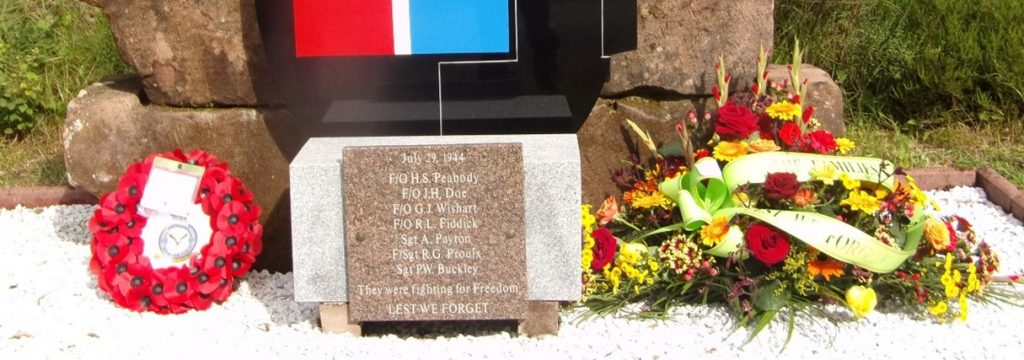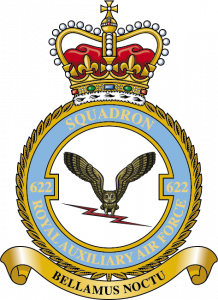During a recent Force Development event in France, 622 RAuxAF Squadron took the opportunity to pay their respects at a Second World War Lancaster crash site (L7576 GI-K) and the graves of the crew. The current Officer Commanding, Wing Commander Doz James laid a wreath at a purpose built memorial, with other Squadron personnel laying squadron crosses on the graves of the crew members.
Below is a short account of the events that led to the shooting down of L7576 GI-K.

Stuttgart nicknamed the “German Coventry” was an important rail hub and a centre of industry, home to the Bosch, Daimler-Benz, and the SKF ball bearings factories. It’s location, spread out in a series of deep valleys, had constantly frustrated the Pathfinders its luck ran out in a devasting set of three raids between 25th and 29th July 1944. The first 2 raids annihilated the city centre with a relatively low loss rate of the attacking bombers. The third raid on a moonlit night with lack of cloud cover left the bomber stream horribly exposed and once identified by German radar plotters proved easy targets for 200-night fighters. L7576 was just one of 39 Lancasters lost that evening, 8% of the bomber stream, falling prey as the first kill to Lt Walter Swoboda piloting a Me110. This proved to be Lt Swoboda’s only victim as he was himself shot down by American Field Artillery 5 months later. The story of what happened to the crew of L7576 makes it stand out from the terrible loss of personnel that night.
GI-K was considered a “lucky crate” and launched on it’s 99th operational sortie piloted by Harold “Al” Peabody a Canadian flying with 622 Sqn, it was his crew’s 8th mission. In the early hours of the 29th July they were attacked and the defensive corkscrew dive was anticipated and a further strafing run at 5000 feet crippled the aircraft.
The wireless operator Sgt Arthur Payton RAF, Mid-upper gunner FS Richard Proulx RCAF and rear gunner Sgt Percy Buckley RAF didn’t survive the attack and remained with the stricken bomber. Buckley had just turned 18 and was possibly the youngest loss of Bomber Command. Flt Lt George Wishart RAF, the Sqn’s Eng leader was a late replacement for the crew’s standard Engineer Sgt David Cosgrove who was sick, baled out but badly injured his leg and couldn’t evade capture.
His injury proved significant as it delayed his handing over to the Gestapo and was passed to the Luftwaffe three days later and remained as a POW for the rest of the War. He was constantly moved from camp to camp, including the infamous Stalag Luft 111, he was forced on the “Long March” the first use of a mass human shield to cover the German retreat, and was finally liberated by allied forces in May 1945. Returning to the UK he lived a good life fathering 4 boys. The fortuitous illness to Sgt Cosgrove proved short lived as his new crew was lost 2 weeks later on a raid against the Opel works at Russelsheim. The Engineer Fg Off Ronald “Lew” Fiddick RCAF also baled out and went on the run. He evaded capture with the aid of local villagers before joining the Marquis French underground. Three weeks after the crash he was picked up by an SAS unit operating behind enemy lines and his skills as a Woodsman before the war proved invaluable to his new colleagues. For his unexpected 3 month tour he was made an honorary member of the SAS and his is well documented in a recent book by Damien Lewis.
Post war he became a Forest Ranger in his native Canada, lived a long and fruitful life and died at the age of 100 in 2016. Post war interviews of Fiddick and Wishart by the RAF’s Missing Research and Enquiry Service (MRES) failed to determine the fate of the two remaining crew the Captain Al Peabody and the Navigator Fg Off James “Harry” Doe RCAF. Gone but not forgotten.
In 2016 Canadian brothers Jon and Robert Peck provided the impetus for further investigation to their fates. Their late Mother had been Al Peabody’s cousin. Funding for a project was established with Bishop’s University, where Peabody had studied pre-war, and three undergrad students took on the case. On sifting through files from the British Army’s War Crime Investigation Team looking into the murder of 29 SAS soldiers of Op LOYTON in NE France at Natzweiler-Struthof, the only Nazi death camp in France, they made a discovery. Three airmen had been executed at Struthof and a Nazi guard identified Peabody from a photograph. No other unaccounted Allied aircrew who had bailed out at the time were documented, so beyond reasonable doubt Peabody and Doe along with Sgt Frederic Habgood shot down on the same night were identified as the mystery airmen. Their murder and subsequent burning in the ovens at Struthof with their ashes placed in a mass grave in the death camp.
The Peabody Project with the assistance of Alain Foune of the Aeronautical Heritage Delegation from Nancy-Ochey FAF airbase commissioned a memorial to the crew. On the 75th Anniversary of the raid a memorial stone was unveiled at Saint-Sauveur near the crash site. The Sqn were honoured to represent the Air Force at the unveiling ceremony in front of family members of the fallen, and military and civilian dignitaries from the local community.
As part of the 622 Sqn Force Development, squadron personnel met up with Alain and members of the heritage society. A Service of Remembrance was carried out at the Petitmont Communal Cemetery at the grave site of Payton, Proulx and Buckley, A short distance away lay the grave of Madeleine Schultz, a French “Flower Girl” who died nearing her 100th birthday, she had tended the graves to our three fallen since 1944. Squadron personnel were told that she discretely took care of the graves by soberly flowering them to the limit of her strength. She mentioned that “she was only doing her duty as a French woman”. Squadron members paid their respects to Madeleine by placing a squadron cross on her grave.
As part of the 622 Sqn Force Development, squadron personnel met up with Alain and members of the heritage society. A Service of Remembrance was carried out at the Petitmont Communal Cemetery at the grave site of Payton, Proulx and Buckley, A short distance away lay the grave of Madeleine Schultz, a French “Flower Girl” who died nearing her 100th birthday, she had tended the graves to our three fallen since 1944. Squadron personnel were told that she discretely took care of the graves by soberly flowering them to the limit of her strength. She mentioned that “she was only doing her duty as a French woman”. Squadron members paid their respects to Madeleine by placing a squadron cross on her grave.
Alain led the group to a valley in the Vosges mountains the crash site of L7576, where the area still littered with wreckage of the aircraft. A wreath laying at the memorial followed on the 79th anniversary of L7576’s 99th and final mission, its luck having finally run out. The memorial comprises of a Lancaster tailplane mounted on a set of 3 stones, the base rock from the crash site, the centre section from Al Peabody’s home in Canada and the nameplate from Lt Swoboda’s Austrian home, a poignant reminder of loss on all sides.
The story of L7576 was completed with a visit to Natzweiller-Struthof. A sombre visit to a beautiful part of the Vosges mountains with an horrific history. The return to base we took the opportunity to visit the grave site of LM477 GI-L at Essey-les-Nancy. The crew of Flight Sergeant Peter Vercoe (Pilot), Flight Sergeant Douglas Pepper (navigator), Flight Sergeant Norman Marsh (wireless operator), Sergeant Richard Duffield (air gunner), Sgt Kenneth Gronow (air gunner) and Sergeant Theophilus Simpson (flight engineer) were lost on the “lucky” and most damaging second raid on Stuttgart a few days earlier from the loss of L7576.
Over the past few years we have been honoured to meet up with a few of our fantastic Squadron veterans all of them talk of the pure luck involved in surviving the war. Luck played a huge part in the story of L7576 for the crew, the aircraft, it’s “target for tonight” and even it’s conqueror.




622 Squadron provides Aircrew and flying support personnel and is based at RAF Brize Norton. Personnel man aircraft in support of the air transport fleet. 622 Squadron recruits solely from Ex Regular personnel.
Find out more below:

